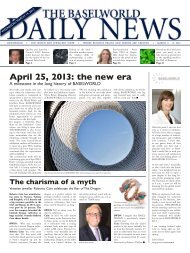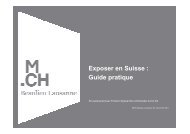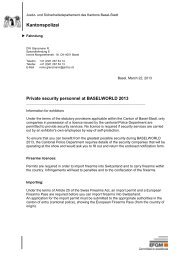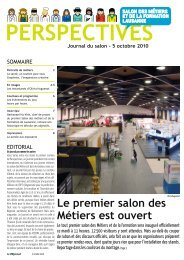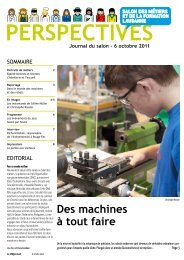WatchTime - August 2012
WatchTime - August 2012
WatchTime - August 2012
Create successful ePaper yourself
Turn your PDF publications into a flip-book with our unique Google optimized e-Paper software.
An uncased movement is timed. This machine does both pressure and vacuum tests without water.<br />
are up to date on the latest movements and<br />
techniques. Technicians with training on all<br />
levels are available to handle almost any<br />
watch complication.<br />
Each workstation has all of the tools<br />
and instruments each watchmaker<br />
needs – sharing would slow things down.<br />
Each watchmaker has a specialty, such as<br />
chronographs, calendar watches, vintage<br />
pocketwatches, etc. However, all watchmakers<br />
work on a variety of movements<br />
to keep their skills sharp and their jobs<br />
challenging.<br />
After the movement is removed from<br />
the case, the dial, calendar display rings or<br />
disks (if any) and hands are taken off and<br />
set aside. The movement is placed in a<br />
holder, dial-side down, and if it is an automatic,<br />
the rotor, reversers and gears are<br />
removed. Next, the mainspring, barrel<br />
and barrel bridge are removed. The mainspring<br />
is inspected and replaced if it appears<br />
to be compromised.<br />
Next, the movement components go<br />
into baskets to be placed in an ultrasonic<br />
cleaning machine, where the combination<br />
of a petroleum-based cleaning agent plus<br />
cavitation (bubbles induced by high-frequency<br />
sound waves) deep-clean everything.<br />
After the cleaning, the parts go<br />
through three ultrasonic rinse cycles, with<br />
each cycle leaving the parts cleaner than<br />
the last. The final step is a heated centrifugal<br />
dryer where a final rinse leaves the<br />
parts spot free. Each of these cycles takes<br />
about 20 minutes, and an especially dirty<br />
movement can go through the multi-cycle<br />
process a couple of times.<br />
116 <strong>WatchTime</strong> <strong>August</strong> <strong>2012</strong><br />
Once the components are clean, the<br />
movement is ready for reassembly and<br />
lube. To lubricate the movement, watchmakers<br />
use both hand and automatic oilers.<br />
Automatic oilers look like pens with<br />
small reservoirs for oil near the tip. Pressing<br />
a button dispenses oil to the tip, which<br />
looks like a very short piece of fine wire.<br />
Hand oilers look like small screwdrivers,<br />
and the tips of the wires have different<br />
shapes to hold different amounts of oil.<br />
The oil is kept in small cups with lids to<br />
prevent contamination and evaporation.<br />
The watchmaker dips the tip in the oil to<br />
pick up just the right amount for a given<br />
application.<br />
Many parts of a movement require lubrication.<br />
On a Rolex caliber 3135, for<br />
instance, the areas that are oiled include<br />
the mainspring and barrel, the pivots or<br />
jewels for all gears, the face of one pallet<br />
stone (typically the entry pallet), the<br />
canon pinion, and several of the winding<br />
and setting components.<br />
ONCE THE MOVEMENT is back together,<br />
it is fully wound and attached to a<br />
Witschi timing machine’s microphone so<br />
that the machine can “listen” to the<br />
watch’s beat rate. The movement is attached<br />
in the dial-down position and allowed<br />
to run for a minute or two to let it<br />
settle down (it only takes the machine<br />
about 10 seconds to determine the beat<br />
rate and amplitude). The timing is<br />
checked before the dial and hands are replaced<br />
to minimize handling those components.<br />
Ideally, the room where the tim-<br />
ing machines operate should be quiet, as<br />
the sensitive microphones can pick up extraneous<br />
sounds, which can affect performance.<br />
A loud machine operating near<br />
a timer can generate a “snow” pattern on<br />
the timer’s LCD screen, rendering the<br />
timer useless. The Stoll & Co. clean room<br />
is very quiet.<br />
Most watchmakers regulate the watch<br />
with the movement still mounted on the<br />
microphone, so they can receive instant<br />
feedback as they make their adjustments.<br />
The microphone is on a motorized<br />
mount, allowing it to run movements<br />
through a series of positions automatically.<br />
Once the watch has been timed in all<br />
positions, the timing results are printed,<br />
and the print-outs are included with the<br />
watches when they are returned to the<br />
owners or retailers.<br />
After the movement is regulated, the<br />
dial and hands are replaced and the movement<br />
is re-cased with all new gaskets.<br />
Gaskets must be replaced, as they can become<br />
dry and brittle. Even if they are relatively<br />
new, gaskets deform after installation,<br />
so new ones should always be installed<br />
at each service.<br />
With the dial and hands installed and<br />
the movement in the case, but before the<br />
caseback is installed, the watch is placed<br />
on the microphone a second time to confirm<br />
that the timekeeping is still within<br />
specs. If not, the movement is regulated<br />
again. Once the timekeeping is verified,<br />
the caseback is installed and the case is<br />
pressure-tested. All timekeeping checks<br />
and pressure testing are performed by the





